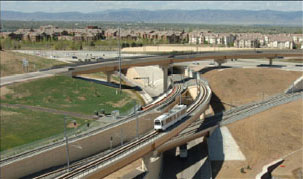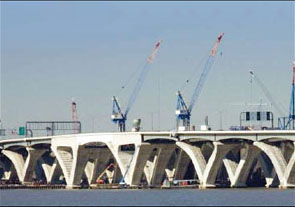The traditional project delivery process has no stage specifically labeled "funding," yet funding challenges affect each stage of the process- from right-of-way (ROW) that can't be purchased due to unavailable funds to a project that completes the environmental process only to have policymakers reject the chosen source of funding. Funding challenges affect project delivery for many reasons:
Explicitly or not, the traditional project delivery process tended to assume that Federal- aid and State funds, based on gas taxes, will be sufficient to cover the costs of projects identified on state plans. Under the old paradigm, projects would move through preconstruction development stages (planning, ROW, design, and National Environmental Policy Act), after which a State Department of Transportation budget official would match the project to an appropriate category of Federal-aid or state funds. Because the category selected would not affect the project's design, this back office" or largely administrative function did not require the involvement of the public, potential private concessionaires, or the capital markets. By contrast, new revenue, finance, and procurement options require project sponsors to engage the public earlier.

Although the assignment of Federal-aid funding categories is rarely a topic of public discussion, addressing the resource constraints that confront major projects requires significant public scrutiny of revenue, finance, and procurement options. Public involvement is critical for public acceptance. Options such as tolling, bonding, Transportation Infrastructure Finance and Innovation Act borrowing, or public-private partnerships may require State- and local enabling legislation or ballot measures. If these options are not considered early in the project development process, significant work can be required to bring the public in later.
Alternative revenue, finance, and procurement options may have implications for the project design. For example, if tolling is considered for a bridge, the design might be different in order to reduce diversion, enhance enforcement capability, and/or provide space for tolling gantries. Similarly, a value capture option (e.g., using revenues from air rights located above a new tunnel) can have design implications. If these options are not considered up front, it can be expensive and difficult to re-do the work.
The traditional project delivery process does not ensure that such revenue, finance, and procurement decisions occur in parallel with the planning, design, and environmental processes. Therefore, the consideration of alternative project delivery options after the issuance of a Record of Decision (ROD ) may trigger a reopening of the environmental process. For example, a State may have to issue a Supplemental Environmental Impact Statement if tolling is added to a project after the ROD has already been approved. This new process may reopen the environmental or alignment conflicts, causing further delay and preventing the project from being delivered.
Federal planning regulations and guidance specify that all projects that receive Federal- aid assistance must appear on a Statewide Transportation Improvement Program (STIP). The STIP must be "fiscally constrained," that is, the State must demonstrate that it has sufficient funds to construct the projects during the term of the STIP.
Yet for projects that have not yet been added to the STIP, past experience with the Federal-aid program often provides State and local transportation agencies significant incentive to delay consideration of alternative funding options. For example, congressional earmarking may reward project sponsors on the basis of their demonstrated need. That may in turn give an advantage to projects with inadequately developed funding plans, versus those that show initiative or local support in getting dedicated funding or identifying innovative revenue, finance, and procurement approaches. Similarly, few States have developed processes to encourage local governments to be proactive in identifying innovative solutions, rather than to wait for their sub-allocations.

Certainly funding shortages are not the only challenges to overcome in the program delivery process. However, because funding-related challenges are not clearly identified as such, they are more difficult to resolve. Highlighting the points in the process where funding causes delay or prevents project development may help States gain public support to obtain needed funding or to consider alternative project delivery options. The traditional project delivery process masks the funding issue and prevents the public from both recognizing and addressing a key challenge to project delivery.
FHWA'S Office of Innovative Program Delivery (OIPD) works to identify issues and improve project delivery by integrating revenue, finance, and procurement options into the delivery process. In addition, OIPD is:
The FHWA Office of Innovative Program Delivery helps State and local transportation officials consider innovation in revenue sources, financial tools, and procurement.
For more information, visit the website:
https://www.fhwa.dot.gov/innovativeprograms/
The FHWA Center for Innovative Finance Support is a one-stop clearinghouse for expertise, guidance, research, decision tools, and publications on highway program delivery innovations. Our website, workshops, and myriad resources support transportation professionals in the use of innovative approaches for delivery of highway projects.
The FHWA Center for Innovative Finance Support's P3 program focuses on resources and capacity building for consideration and use of design-build-finance-operate-maintain (DBFOM) concessions funded through tolls or availability payments.
The FHWA Center for Innovative Finance Support's Alternative Project Delivery program provides information on contractual arrangements that allow for greater private participation in infrastructure development by transferring risk and responsibility from public project sponsors to private sector engineers, contractors and investors.
The FHWA Center for Innovative Finance Support's Project Finance program focuses on alternative financing, including State Infrastructure Banks (SIBs), Grant Anticipation Revenue Vehicles (GARVEEs), and Private Activity Bonds (PABs).
The FHWA Center for Innovative Finance Support's Federal Tolling and Pricing program focuses on the use of tolling and other road user charges as a revenue source to fund highway improvements, and the use of variably-priced tolls as a tool to manage congestion.
The FHWA Center for Innovative Finance Support's Value Capture program explores strategies for tapping into the added value that transportation improvements bring to nearby properties as a means to provide new funding for surface transportation improvements.